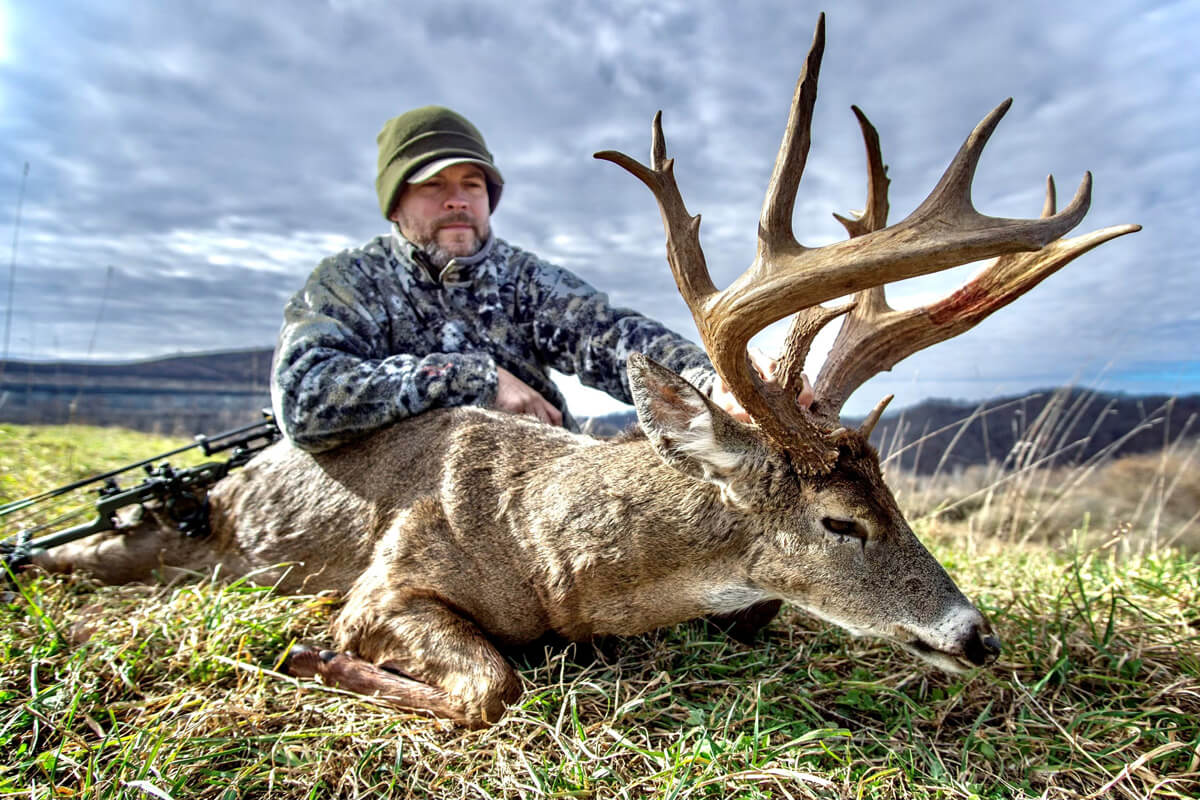
This 170-class buck was taken by David Miller while bowhunting West Virginia’s archery-only area last fall. The deer, which had 20 scorable points, was the fourth Boone and Crockett-range buck that Miller has taken in the past four years. (Photo courtesy of Reuben Browning)
As we get ready to break into 2024, this kill is our final look back into the fall of 2021. If you missed the other monster bucks we’ve already covered, be sure to check them out — including the Dustin Huff buck (Indiana), the Mike Callas buck (Iowa), the Zach Meadows buck (Oklahoma), and the David Souza buck (Ohio).
Mountain State Monster — David Miller, West Virginia
West Virginia probably isn’t the first state one thinks of when envisioning world-class whitetail hunting, but Logan, McDowell, Mingo and Wyoming counties in the southern part of the state routinely give up some impressive bucks, primarily due to the rugged terrain and the fact that deer hunting is limited to archery-only in that four-county area. Just one example of the quality whitetails coming from the region is David Miller’s 2021 non-typical, a magnificent buck that scored well over 170 inches.
A wildlife consultant and biologist, Miller has been hunting the archery-only counties for decades, taking four Boone and Crockett-range bucks the past four years. His strategy is to ‘hunt’ from afar, relying on trail cameras to identify bucks with good potential. Then, if he finds one that he’s interested in, he avoids hunting that area for a few years to give the buck time to grow.
“I just leave them alone completely so there’s no pressure,” Miller said. “I hunt other areas.”
Miller’s 2021 target buck was one he originally identified in 2017 on a lease he has in Logan County. Although he’s had access to the property for six years, last year was the first time he actually stepped foot on it to hunt.
“I had watched it develop,” Miller said. “There were specific characteristics about its antlers that allowed me to be able to identify it pretty early on. One side of its antlers, the brow tine’s sort of cascaded over and it carried that all of its life.”
After getting a good handle on the buck’s patterns last summer, Miller had to relocate the deer when it vanished in early October. Using topo maps, he strategically moved his trail cameras around, placing them out in a grid format until he was able to find the buck once more. In early November, the deer started showing up again, but Miller broke one of his cardinal rules when he decided to go in after it. Although he typically avoids hunting down in the hollows because of how thermals interact with the wind and carry human scent, he took a gamble by setting up on the fringes of one particular drainage since he thought that was his best shot at the deer.
“It was a hang and hunt (sit), so I hung my stand that morning and got in there,” he said. “Sure enough, I got an opportunity at him about 9:30 (as he was) going to bed, and about 70 yards out he picked my wind up and blew out. I thought I was done.”
Although the deer basically disappeared from Miller’s trail cams following that encounter, it returned a few weeks later and was appearing regularly during daylight. After getting multiple photos of the buck on Nov. 21 and the following morning, Miller decided the time was right to try again.
“I knew that evening I had to get into that stand, so I parked further away than I normally do and was extremely cautious with my scent and the way the wind was blowing,” Miller said. “I eased in there and got into my stand about 3 o’clock. I was just kicked back; there were two does that came in and they were feeding in a little early successional growth area that I had.”
Around 4 p.m., Miller heard something in the leaves behind him, but he was caught off guard when he turned around and saw the big buck coming off the ridge since he didn’t anticipate the deer coming from that direction.
“He came 3-4 yards from my tree, directly under me,” Miller said. “At this point, I’m frozen. I can’t move and he goes out to check those does, out to about 22 yards. When he had his back to me going toward the does, I started to ease up and get my bow.”
Seconds later, Miller drew back his Mathews V3, unleashing a Gold Tip Kinetic Pierce arrow and QAD Exodus broadhead. The deer traveled 60 yards after the shot before tumbling over a rock embankment. Extracting the big buck from the rugged terrain was an arduous task, with Miller and two friends using an ATV and 120-foot rope to pull the buck up the hill, three feet at a time.
Following the 60-day drying period, Miller’s buck was officially scored at 174 ⅝ gross. The deer, which had 20 scorable points, was aged at an impressive 7.5-years-old. Miller says the experience of pursuing and taking the buck was bittersweet, since he had recently lost his father, Charles, but it also taught him a valuable lesson.
“It seems like that with all of the mature deer I’ve been blessed to harvest in my life, there’s a story that comes out of it — there’s something like a lesson,” he said. “And the lesson from this deer was because of the adversity that happened chasing that deer, and two weeks before harvesting that deer I lost my father, I learned the importance of being persistent and the importance of being patient.”











































